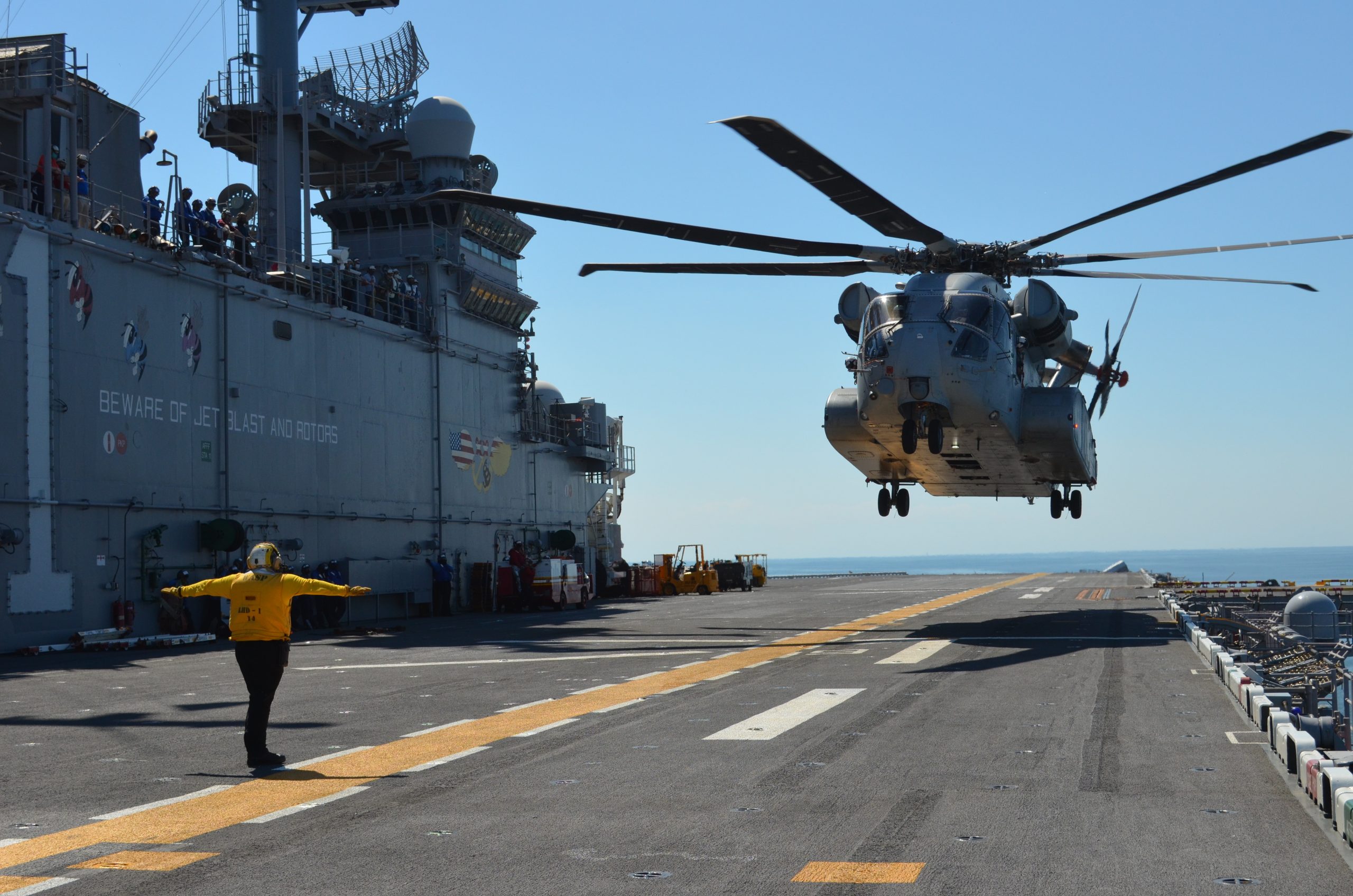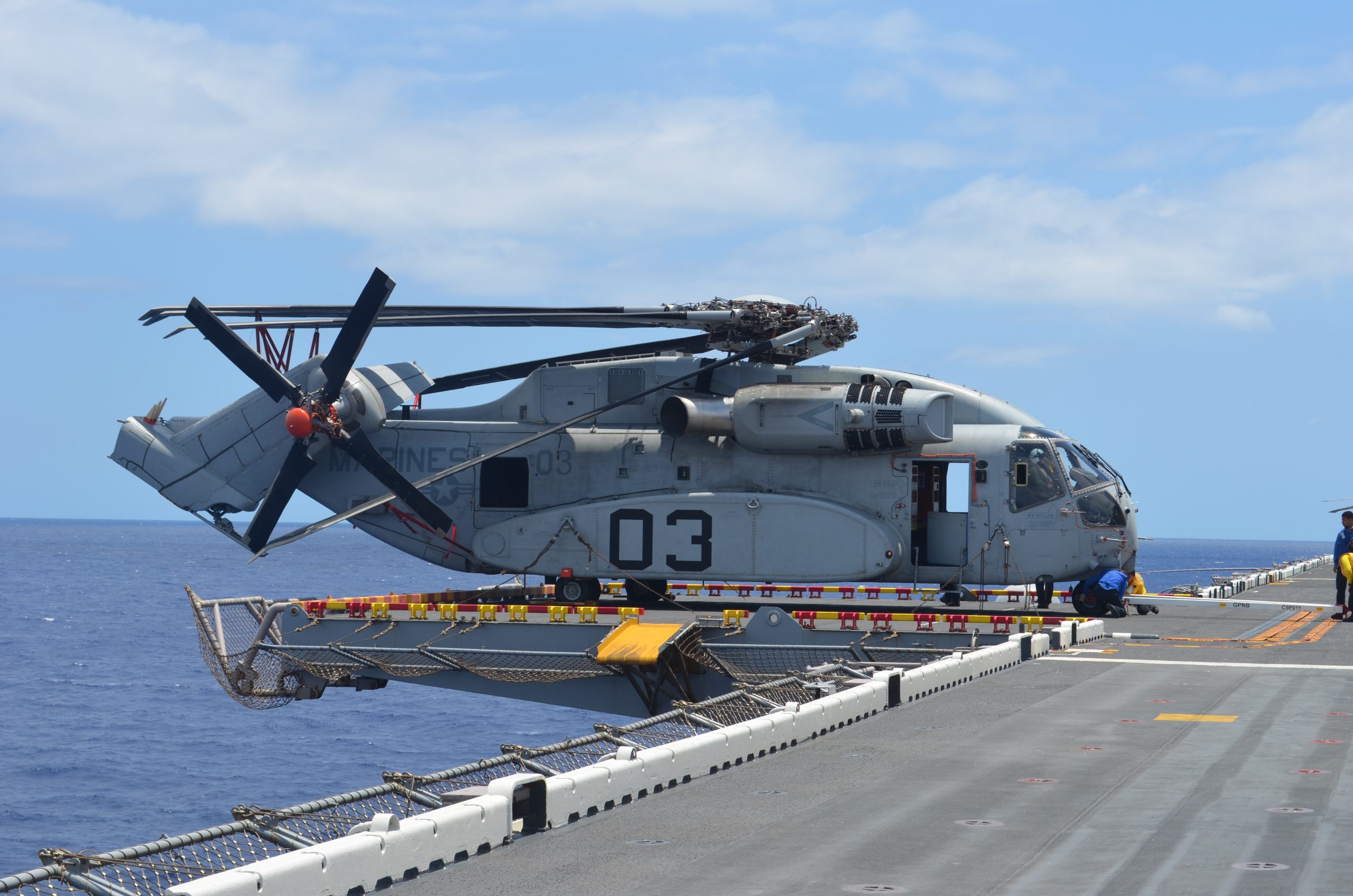By Robbin Laird
During my visit to 2nd Marine Air Wing during the first week of December 2020, I had a chance to visit New River Marine Corps Air Station and meet with Lt. Col. Frank, VMX-1, to get an update on the coming of the CH-53K. Lt. Col. Frank showed me the simulator as well giving me a chance to experience the flying qualities and, notably, the ability to hover via using the automated systems to operate in difficult visual and operating conditions.
He joined the USMC in 2002 and has flown a wide variety of rotorcraft during his career and served as a pilot for the U.S. President under President Obama. He came to VMX-1 in 2018. He has stayed in large part to follow through the CH-53K to fruition, that is into operations.
As he put it: “It is crucial to have a CH-53 fleet that works effectively as it is a unique capability in the USMC crucial for our way ahead operationally. It is the only aircraft we have that can move an expeditionary brigade off of our amphibious ships.”
“We have about a hundred Marines here at the test detachment. We’ve been training our maintainers and our air crew on the 53K for two years now. The maintainers have been working on it since 2018, when we started the logistics demonstration, which is essentially the validation of maintenance procedures on the 53K. I have 10 pilots in the det including myself and I’m responsible for ensuring that everyone goes through the proper training syllabus.”
“All 10 of our pilots in addition to our crew chiefs and our maintainers will be the first unit to be allowed to operate a “safe aircraft for flight,” which is a term we use for the maintainers.
“Our job is to conduct initial operational test and evaluation training for six months, beginning this month and ending in May or June of 2021, where we will establish five aircraft commanders, myself being one of them, five co-pilots, that’ll be our 10 pilots.
“We’ll qualify 10 crew chiefs, and our maintainers will continue to advance in their maintenance quals. In June of 2021 is when we enter into IOC evaluations.”
“We’re going to evaluate the reliability and maintainability of the aircraft. We’re going to collect all our maintenance data, determine how long it takes to fix, how long it’s down before it’s fixed and how many flight hours it accomplishes per maintenance man hour to evaluate it.
“We will evaluate Its shipboard compatibility in June and July 2021. We are to evaluate its desert mountainous capabilities in Twentynine Palms, beginning of August and September 2021. And we also have a sorties generation rate demonstration where we will execute a surge capability of sorties from a ship in November 2021; we’ll do that for a period of about 72 hours straight, where we will fly every aircraft every day and see what they deliver.”
We discussed the importance of the fly by wire system in the aircraft, which he considers “very mature.” He did note that the USMC subjects its aircraft to some of the harshest environments in the DoD, “salt spray, open ocean, desert heat and freezing cold.” Robustness is a crucial aspect of determining reliability. “We do not operate runway to runway. We do not store them inside; we use them in challenging conditions.”
He referred to his team as “the learning curve for the CH-53K,” similar to what happened with the Osprey or the F-35B.
He underscored that the aircraft is well along the path to IOC.
“We’ve had a lot of time with the aircraft. Our Marines have been working on it for two years now. During logistics demonstration, we took the publications, which were in their infancy, and we went through every work package.
“The bulk of the Marine Corps’ CH-53K personnel, equipment, aircraft, and support will be located at VMX-1 when the Marine Corps declares the CH-53K program is IOC.”
Lt. Col. Frank described the innovation cycle as follows: “When problems come up with the aircraft, we bring up to the program office, the program office sends it out to engineering and industry. They implement changes. They implement engineering fixes, and they incorporate them.”
While at New River, we visited the first of the CH-53Ks delivered to VMX-1, which I had seen earlier in the log demo program but now was on the tarmac.
LtCol. Frank indicated that VMX-1 is to receive six aircraft overall.
“We are to receive our next aircraft on January, February, June and September of 2021, and the last one on January of 2022. By January 22, when the sixth aircraft is delivered, we should be done with IOT and E and we should carve out a detachment size group of maintainers, pilots, and aircraft from VMX-1 to form the initial cadre of HMH-461.”
How does he compare the Es to the Ks?
“I’ve started in the Ch-53D in 2004, they’re my first love. I’ll always love them.
“They were much harder to fly. And the ease of flying this, the flight control system is probably the biggest game changer for the 53 community.
“We’re not used to anything like this. It’s very intuitive. It can be as hands off as you know, a brand-new Tesla, you can close your eyes, set the autopilot and fly across country.
“Obviously, you wouldn’t do that in a tactical environment, but it does reduce your workload, reduces your stress.
“And in precision hover areas, whether it’s night under low light conditions, under NVGs, in the confines of a tight landing zone, we have the ability to hit position hold in the 53 K and have the aircraft maintain pretty much within one foot of its intended hover point, one foot forward, lateral and AFT, and then one foot of vertical elevation change.
“It will maintain that hover until the end of the time if required. that’s very, very stress relieving for us when landing in degraded visual environments. Our goal at VMX-1 is to create tactics that employ that system effectively.
“Some communities struggle with how they use the automation, do they let the automation do everything? Do they let the pilots do everything? How to work the balance?
“We’re working on a hybrid where the pilots can most effectively leverage automation.
“If you know you’re coming into a brownout situation or degraded visual environment, you engage the automation at a point right before the dust envelops you. And then in the 53-K, you can continue flying with the automation engaged.
“You continue flying with the automation engaged, and you can override it, but as soon as you stop moving the controls, it will take your inputs, estimate what you wanted and keep the aircraft in its position.
“It’s a very intuitive flight control system, and it blends very well with the pilot and the computers. It allows you to override the computer.
“And then the second that you stop overriding it, the computer takes back over without any further pilot input.
“That’s probably the biggest game changer for our community.”
Also, see the following:
Flying the CH-53K: Visiting Marine Corps Air Station New River




